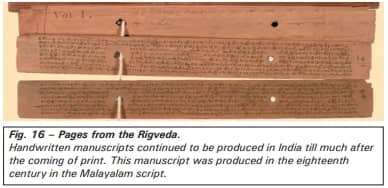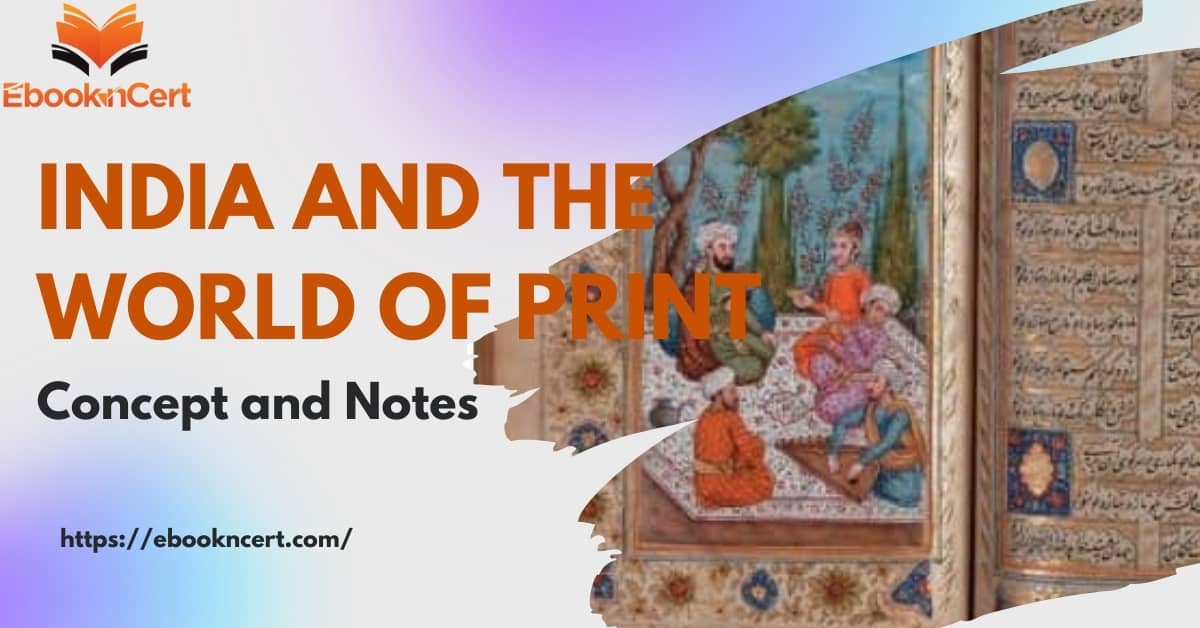NCERT History Class 10 | India and the World of Print – Concept and Notes
Topics Covered
ToggleTopic & subtopics covered: India and the World of Print, Manuscripts Before the Age of Print, Print Comes to India: Print Culture and the Modern World (All single detail notes are exam-oriented).
We have discussed in-depth and exam-oriented pointers that can be asked in the board exam of class 10th about “India and the World of Print, Manuscripts Before the Age of Print, Print Comes to India class 10 notes” which is taken from the NCERT History book for class 10th chapter no. 5 “Print Culture and The Modern World“.
Download NCERT History Chapter 5 Class 10th Notes PDF for “Print Culture and The Modern World”
If you are in class 10th and looking for free NCERT History chapter 5 notes of the chapter Print Culture and The Modern World class 10 that cover concepts, then you can download the free class 10th History chapter 5 notes “Print Culture and The Modern World”. You should download this free PDF for future tests or exam preparations.
NCERT Class 10 History Chapter 5 Print Culture And The Modern World Class 10th Notes & Concept
India and the World of Print
Manuscripts Before the Age of Print


1. Tradition of Handwritten Manuscripts in India:
- India had a rich tradition of handwritten manuscripts in languages like Sanskrit, Arabic, Persian, and various vernacular languages.
- Manuscripts were copied on palm leaves or handmade paper, sometimes featuring intricate illustrations.
- Preservation techniques included pressing between wooden covers or sewing pages together.
2. Challenges with Manuscripts:
- Manuscripts were expensive and fragile, requiring careful handling.
- Different script styles made reading difficult, limiting their widespread use in everyday life.
3. Education System and Manuscript Usage:
- Pre-colonial Bengal had village primary schools, but students often learned to write without reading texts.
- Teachers relied on memory to dictate portions of texts, and students transcribed them, resulting in literacy without actual reading experience for many.
Print Comes to India Class 10 Notes
1. Introduction of the Printing Press in Goa:
- Portuguese missionaries brought the printing press to Goa in the mid-sixteenth century.
- Jesuit priests printed tracts in Konkani, with around 50 books printed in Konkani and the Kanara languages by 1674.
2. Printing in Tamil and Malayalam:
- Catholic priests printed the first Tamil book in 1579 at Cochin and the first Malayalam book in 1713.
- Dutch Protestant missionaries printed 32 Tamil texts by 1710, translating older works.
3. Emergence of English Language Press:
- English language press in India developed relatively late, despite the presence of the English East India Company importing presses from the late seventeenth century.
- James Augustus Hickey initiated English printing with the Bengal Gazette in 1780, emphasising its independence from colonial influence.
4. Significance of Bengal Gazette:
- Bengal Gazette, edited by Hickey, served as a weekly magazine and commercial paper open to all.
- It published advertisements, including those related to the import and sale of slaves, and gossip about the Company’s officials, leading to conflicts with Governor-General Warren Hastings.
5. Response to Independent Press:
- Warren Hastings persecuted Hickey and supported officially sanctioned newspapers to counteract negative information about the colonial government.
- The late eighteenth century saw the emergence of several newspapers and journals, including Indian-owned publications like the weekly Bengal Gazette by Gangadhar Bhattacharya.
Next & Previous Topics of NCERT/CBSE History Class 10 Chapter 5: Print Culture and the Modern World
MCQs on NCERT History Class 10 Chapter 5 Topic – India and the World of Print
Here are the top exam-oriented MCQ-type questions on “India and the World of Print” that you should prepare for your CBSE or state board exams:
Question 1. What material were Indian manuscripts traditionally written on?
(a) Papyrus and silk
(b) Palm leaves and handmade paper
(c) Bamboo sheets
(d) Stone tablets
Answer: (b) Palm leaves and handmade paper
Question 2. Which languages were Indian manuscripts commonly written in?
(a) English and French
(b) Sanskrit, Arabic, Persian, and vernacular languages
(c) Latin and Greek
(d) Only Sanskrit
Answer: (b) Sanskrit, Arabic, Persian, and vernacular languages
Question 3. What was a common method used to preserve manuscripts?
(a) Wrapping them in cloth
(b) Pressing between wooden covers or sewing together
(c) Storing them in glass cases
(d) Laminating them
Answer: (b) Pressing between wooden covers or sewing together
Question 4. Why were manuscripts not widely used in everyday life?
(a) They were written in foreign languages
(b) They were highly expensive and fragile
(c) They were available only in royal courts
(d) They were not considered important
Answer: (b) They were highly expensive and fragile
Question 5. What was the primary focus of students in pre-colonial Bengal’s village schools?
(a) Reading texts extensively
(b) Learning to write dictated portions of texts
(c) Memorising mathematical formulas
(d) Studying religious scriptures
Answer: (b) Learning to write dictated portions of texts
Question 6. Where did the printing press first come to India?
(a) Bengal
(b) Goa
(c) Madras
(d) Bombay
Answer: (b) Goa
Question 7. Who introduced the printing press in India?
(a) English East India Company
(b) Portuguese missionaries
(c) Dutch traders
(d) French colonists
Answer: (b) Portuguese missionaries
Question 8. Which language was the first Tamil book printed in, and where?
(a) Malayalam, Cochin
(b) Tamil, Cochin
(c) Konkani, Goa
(d) Kanara, Goa
Answer: (b) Tamil, Cochin
Question 9. Who printed the first Malayalam book in India?
(a) Portuguese missionaries
(b) Catholic priests
(c) Dutch Protestant missionaries
(d) Jesuit priests
Answer: (b) Catholic priests
Question 10. By 1710, which group had printed 32 Tamil texts?
(a) Jesuit priests
(b) Dutch Protestant missionaries
(c) Catholic priests
(d) Portuguese traders
Answer: (b) Dutch Protestant missionaries
Question 11. Who started the first English language newspaper in India?
(a) James Augustus Hickey
(b) Warren Hastings
(c) Gangadhar Bhattacharya
(d) Rammohun Roy
Answer: (a) James Augustus Hickey
Question 12. What was the name of India’s first English newspaper?
(a) The Indian Times
(b) Bengal Gazette
(c) Calcutta Chronicle
(d) The Hindu
Answer: (b) Bengal Gazette
Question 13. What description did Hickey’s Bengal Gazette give itself?
(a) “A literary paper open to all”
(b) “A commercial paper open to all, but influenced by none”
(c) “An independent paper for intellectuals”
(d) “A government-sanctioned news outlet”
Answer: (b) “A commercial paper open to all, but influenced by none”
Question 14. What led to James Augustus Hickey being persecuted by Warren Hastings?
(a) Publishing anti-British propaganda
(b) Publishing gossip about Company officials
(c) Refusing to pay taxes
(d) Printing religious material
Answer: (b) Publishing gossip about Company officials
Question 15. Which Indian was the first to publish a newspaper in India?
(a) Raja Rammohun Roy
(b) Gangadhar Bhattacharya
(c) Bal Gangadhar Tilak
(d) Ishwar Chandra Vidyasagar
Answer: (b) Gangadhar Bhattacharya
Question 16. What was the name of the Indian newspaper brought out by Gangadhar Bhattacharya?
(a) Calcutta Chronicle
(b) Weekly Bengal Gazette
(c) Indian Times
(d) Hindustan Gazette
Answer: (b) Weekly Bengal Gazette
Question 17. What was the relationship between Gangadhar Bhattacharya and Rammohun Roy?
(a) Friends
(b) Business partners
(c) Relatives
(d) Political opponents
Answer: (a) Friends
FAQ
Q1. What was the tradition of manuscripts in India before the introduction of printing?
Answer: Handwritten manuscripts were prevalent in India, written in languages like Sanskrit and Arabic on palm leaves or handmade paper. However, they faced challenges such as fragility and readability.
Q2. How did printing come to India, and what were its early impacts?
Answer: Printing arrived in Goa through Portuguese missionaries in the 16th century. It later expanded to Tamil and Malayalam languages. The introduction of English language press, notably the Bengal Gazette, marked a significant milestone in print culture.
Q3. What was the significance of the Bengal Gazette, and how did it shape colonial interactions?
Answer: The Bengal Gazette, established by James Augustus Hickey in 1780, was the first English-language newspaper in India. It served as a platform for commercial advertisements and political gossip, leading to conflicts with colonial authorities like Warren Hastings.
Q4. What is manuscript Class 10?
Answer: A manuscript is a handwritten document or book that was used before the invention of the printing press. These were written on materials like palm leaves or handmade paper and often contained important historical, religious, or cultural texts. Manuscripts were laboriously copied by hand, making them rare and expensive. They played a crucial role in preserving knowledge in ancient and medieval times.
Q5. How are manuscripts printed in India Class 10?
Answer: In ancient India, manuscripts were not printed but written by hand on palm leaves or birch bark using ink and a stylus. However, after the arrival of the printing press in the 16th century, manuscripts were sometimes printed for wider circulation. This was done by typesetting the handwritten text and reproducing it through the printing press. Modern printing in India now uses advanced machines, but manuscripts are also digitised or printed as facsimiles to preserve their content and make them accessible.

